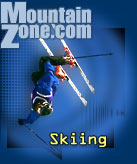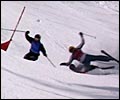
Snowbird Freeskiing Nationals
Despite Brutal Crashes and Major Falls, Athletes Unscathed
Snowbird, Utah - February 12, 2002
 | |
| Spills & Thrills (12 images) | |
First off is skiercross, brutal elbow-to-elbow combat in which four to six racers simultaneously jockey through a terrain park filled with bumps, banked turns, and jumps. Body positioning is critical so strength and size are determining factors and the top two racers from each heat go on to the next round.
"Jamie [Burge] is the only woman who gets inverted and by many accounts consistently outperforms the men..." |
In the other semi-final race, Enak Gavaggio and Xavier Kuhn narrowly avoided a collision which ultimately propelled them into the finals uncontested. Erik Anderson and Erik Archer were not as lucky as they were flung from the course when skis became tangled in one of the last turns.
The finals went off without any falls, but contact decided the difference between 2nd place and and 3rd. "The Rock" McCullough earned his name when he found the inside position and edged out Xavier Kuhn for 2nd place. Niklas Sundqvist finished 4th overall, and Gavaggio of Les Arcs, France, was alone in the end with a lead comfortable enough to float a nice spread eagle over the last jump.
The skiercross was just an appetizer for the bold freeskiing entree. Fifty-three athletes attempted to qualify with seven women and 19 men advancing to the finals. Despite heated competition, victors in both divisions defended their 2001 US Freeskiing National Titles.
As Jeremy Nobis, former Olympian and one of the judges commented, "freeskiing is a beautiful expression of an athlete's power and grace displayed while navigating over enormous terrain. Technical skill is not enough to win a competition. Granted, it is important to know why the skis do what they do, but it is more critical to be able to memorize lines and be comfortable with risks and the consequences they might bring."
Freeskiers are strong and can read the mountains from a distance. High speeds and enormous airs characterize the event, but organizers try to make the event safe by their emphasis on skier control. If an athlete falls, especially above cliffs, he or she will not win. Competing successfully in this subjectively evaluated sport is a gradual evolution for the athletes. They must interpret how to ski the mountain in a way that fits his or her skills, stamina, and the likings of the judges.
Competitors are evaluated on line difficulty, control, fluidity, technique, and aggression. Each category is given a score between one and 10, with no category more than two points higher than the line score. Five judges average their scores to determine the winner.
Jamie Burge from Lake Tahoe, California, took the lead in the women's division with the best run of the first day by choosing a more technical line than any of the men and then skiing it conservatively in order to maintain her lead. Jamie is the only woman who gets inverted and by many accounts consistently outperforms the men.
Jennifer Ashton skied rocky faces, landing airs over 30 feet in her attempt to steal the lead from Burge on Day 2. The strong Canadian big-mountain skier had the best run of the second day, but it was not enough to catch up with Burge. Ingrid Backstrom of Crystal Mountain, Washington, slipped from 2nd to 3rd while local favorites Linda Peterson and Laura Ogden of Alta/Snowbird, Utah, finished 4th and 5th, respectively.
Jen Berg who has won at Snowbird before, wowed the crowd with a heart-stopping fall over three separate cliff bands. After a rock stopped her downhill ski in one of the steepest sections of Mt. Baldy, she rolled to land back on her skis. There was nothing under them by that time, and she fell backward first and mostly upside down. She landed hard and, with no time to recover, was already free falling over another cliff. Bouncing at the base, she rolled over yet another cliff miraculously waving to the audibly relieved crowd only moments later. In total, Jen had fallen upwards of 90 feet!
In the men's division, Kaj Zachrisson of Sweden led after the first day. A fall on his first run of the second, however, bumped him out of contention. Frenchman, Guerlain Chicherit was waiting to take the lead. Nobis describes Chicherit as "a fluid and intuitive skier who sticks big airs" and as "a stuntman who is comfortable in the air." This was apparent as he skied 40-degree slopes at over 40-miles-per-hour!
The Canadian Hugo Harrison climbed from 7th to 2nd place on his final run of the second day with technically strong, high-speed skiing. Harrison also finished 2nd in the Canadian Freeskiing Nationals in Whistler. He managed to finish his second run at Snowbird on a broken ski.
Rick Greener of Snowbird/Alta highlighted the competitive spirit of the second day. Starting from 17th place, Greener rose to the occasion with high speed, air-to-air, giant slalom turns, knowing that a fall would make him finish last. After the 200+ pounder stomped consecutive airs at high speed, he arrived at the base of Baldy in 3rd place.
Gavaggio, winner of the skiercross, finished 4th. Aaron Estrada of Aspen, Colorado, finished 5th ahead of Kaj Zachrisson of Sweden in 6th. There was a two-way tie for 7th between Canadian Pierre-Yves Leblanc and Sverre Lilliquist of Sweden. Americans Aaron Hunt and Jamie Blair finished 9th and 10th.
Athletes in this year's freeskiing competion successfully avoided any major injury, in part because of their high skill and protective gear. The "turtle shell" spine cover used in both the skiercross and freeski events is a beautiful safety feature worn by the modern extreme athlete.
In big mountain skiing, there is high risk for little dollars, but as a tribute to the character of those who enter such contests, the shear challenge and the love of skiing are enough to make it worth the risk.
— Art Holscher, MountainZone.com Correspondent
|
|
